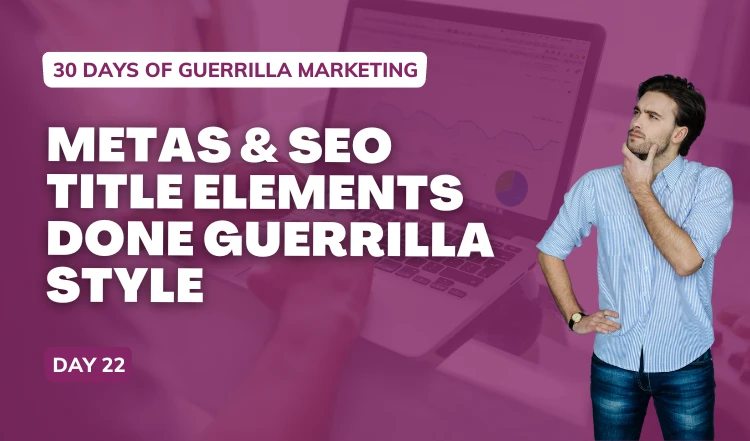What is Content SEO?
Content SEO is creating content with the intent of ranking in the search engine results. When a user searches for something related to your content, you want it to show on the first page of the results. Content SEO includes the content you write as well as the way it is structured on your webpage.
Search engine algorithms are somewhat of an enigma. While not many know the exact formula for ranking at the top of the first page of results, there are experts who have analyzed top-ranking pages to determine what factors cause a piece to rank on the first page of Google.
Essentially, content that ranks well considers three main elements (and we have an article that dives into each of them):
- Keyword strategy
- Site structure
- Copywriting
Search engines, like Google, read your website to determine what information is offered and how helpful it will be to the person searching. The words you use on your site are part of what determines whether your site will rank. The words in your content need to align with what the searchers are looking for.
In addition, your website should be easy to use and well-designed with a user-friendly interface. But even if your website is perfect, without informational, quality content, your site will never hit the first page of search results.
Keyword Research
You’ve probably heard of keywords and how important they are to SEO. But what are they really, and how can you make them work for you?
What Is Keyword Research?
Keyword research is the process of identifying specific words and phrases that you want your web pages to rank for. Content SEO strategy always starts with rigorous keyword research. Knowing what your audience is searching for is the key element to generating organic traffic to your site. Keyword research helps you to know what words and subjects you should be aiming for.
Keyword research can essentially be broken down into four main parts:
- Establish the goals of your content strategy
- Make a list of the keywords that match your content to your target audience
- Understand search intent
- Create landing pages for the keywords
When keyword research is done well, it should give you a clear understanding of what search terms people are using and how you can create content to rank for those words. Knowing these things will help you write content that will attract organic traffic.
Why Is Keyword Research Important?
Keyword research is how you determine which search terms your audience is using to find information, products, answers, etc. It’s crucial to the success of your content strategy that you and your audience are using the same terms.
In some instances, you may use a particular term for one thing while your audience uses an entirely different term, and that makes it almost impossible for you to find each other.
Optimizing your content for words that your audience isn’t using doesn’t make any sense, and it won’t help you improve your rankings. Proper keyword research is what makes your content work for you and makes the effort of optimizing your website worthwhile.

Heads or Tails?
Keywords don’t have to be a single word. Some keywords are made up of multiple words. Sometimes, keywords can be actual key phrases.
There are two main types of keywords:
- Head keywords are typically made up of 1–2 words and are more difficult to rank for because they are generally more broad terms.
- Long-tail keywords are generally made up of 3–4 words that are much more specific and therefore have less competition and are easier to rank for.
Classifying your keywords is important to the success of your SEO content strategy. While some keywords are broad and therefore more competitive, others are longer and more specific. This makes them easier to rank for because fewer people are using them in their content.
They may not bring as much traffic, but the traffic they do bring will be very targeted and eager to consume the information you provide them.
The trick is deciding which keywords are the most critical high-level keywords. They will generate a good amount of traffic for your website and are the best fit for your business. You’ll probably target a few general, short-tail keywords and more that are long-tail. We will talk more about that later.
There is less competition over long-tail keywords because fewer people have written content about them. That may sound bad, but it’s good if you learn how to use them well. Less content means less competition.
Because the competition is lower, it’s easier to rank for long-tail keywords. Also, you may find it easier to target a specific search intent with a long-tailed keyword.
The best way to find good long-tail keywords you can rank for is to focus on a niche. Niching down involves targeting a very specific group of people within your market. You can rank higher by targeting your content to that very specific group with those long-tail keywords.
By writing high-quality content about a very niche topic, you can beat out even the largest competitors for those long-tail terms.
You can target the people looking for information about that long-tail keyword. If you have a shop, you can target the people who want to buy products associated with that long-tail keyword. If you’re looking to target a local market, you can also include some location-specific keywords.
The most competitive keywords you’re trying to rank for should be on the top-level pages of your website – think home page and maybe one level down. Your content that focuses on long-tail keywords can be on the deeper levels of your website.
You can try to rank for the more competitive head keywords, but the odds are high that you’ll rank very low in the Search Engine Results Pages (SERPs).
Starting out with the less competitive but better ranking long-tail keywords will build your credibility with the search engines, and once you have a few articles under your belt you can start trying for those more competitive terms.
How Many Keywords Should You Target?
It’s hard to know exactly how many keywords you should focus on. You should have as many as you can come up with, and that will differ depending on your industry and type of business.
Even the smallest business will likely end up identifying more than a hundred relevant keywords. You don’t have to create content for each of them all at once. Use the keywords you want to rank for first in your first pieces of content, and you can gradually add the rest as you create more content.
Keyword and Search Intent
One thing search engines are really paying attention to these days is the intent of the search query being used.
What type of information is the searcher looking for when they type in your keywords?
Sometimes, keyword intent is clear like “buy a pet” or “how to train a puppy”, but it isn’t always that simple.
There are four types of search intent:
- Informational intent: User’s trying to find answers to specific questions about a specific topic.
- Transactional intent: The user is looking to make a purchase.
- Commercial intent: Thinking of making a purchase in the near future, the user is doing research and gathering information.
- Navigational intent: The user knows the specific website they want to visit, but rather than entering the specific address, they enter the name into the search engine.

Knowing the intent of your visitors’ searches will greatly improve your ability to create the content they’re looking for. High-quality, intent-based content will greatly increase the chance of a user visiting your site and clicking on various pages.
Search engines have developed intricate algorithms to gather data and interpret what the primary intent of a search is. Their goal is to choose the results that best match the user’s intent and present them in an ordered fashion.
Within the four main categories of user intent, there’s a significant amount of variation in what exactly the user is looking for. Search engines also make some assumptions about what people are looking for.
Remember, the web is worldwide.
Sometimes it has to take into account that your search query isn’t as literal as it may sound.
For example, if you type “white house” into the search bar, Google understands that you probably aren’t looking for information about houses that are white. You’re probably looking for information related to the actual White House, the residence of the President of the United States.
Likewise, some search queries have multiple meanings. My favorite example is a search query for Mercury. This one word has several different meanings:
- The planet Mercury
- The element Mercury
- The Roman god of commerce, Mercury
- Mercury Marine Outboards
- Freddie Mercury (lead singer of rock band Queen)
- And more
Search engines will try to use semantics and Natural Language Processing (NLP) to figure out which one, in particular, the user is looking for. They will also keep track of which one most people clicked on in the search results to determine which is the one with primary search intent.
The goal of search engines is to provide the consumer with the exact information they’re looking for. With that in mind, if most people searching for your keyword have informational intent, but you’ve optimized your content to make sales, you probably aren’t going to have a lot of luck ranking.
Search Engine Results Pages (SERPs)
When you’re doing keyword research and trying to discover the search intent of users, you can use the SERPs to help.
By searching the keyword and examining the search results, you can get insight into what people are looking for when they use your keywords. SERPs are a direct source of information about what users are looking for. SERPs can also show you new keyword opportunities and how you can adjust your SEO strategy.
From there, you can create content that is specific to the needs of the people searching. This is an important part of your keyword strategy, as search engines rank more and more based on intent.
Adapting Keyword Strategy
Keyword strategy doesn’t ever stay the same. Much like the algorithms developed by search engines, they evolve over time. Your strategy should evolve along with your business and content.
As your business changes, as new products are developed and offered, and new markets are sought, you’ll need to grow your list of keywords.
There is no right or wrong keyword strategy. You can start by trying to rank for your top long-tail keywords and then move to more competitive keywords. Or you could start with the more general terms and look for long-tail keywords after.
Don’t be afraid to focus on more niche terms and then broaden your approach, adding more content on different topics along the way.
Are you ready to expand your growing knowledge of content SEO? If so, click here to read our article on site structure. It may not be exciting, but it’s very informative and will save you lots of time as you build out your content.





